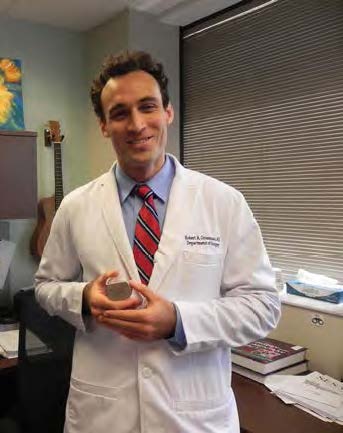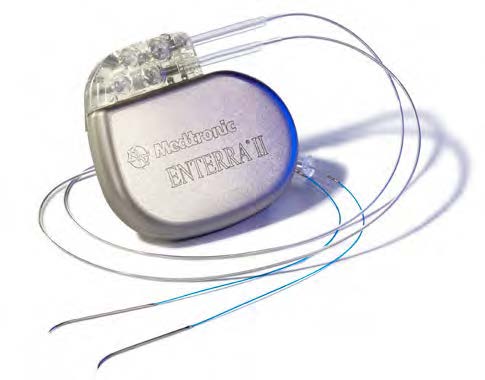Electronic Implant Offers Hope

Dr. Robert Grossman with Enterra II
If you or a loved one suffers from the chronic nausea and vomiting that are indicative of gastroparesis, you know just how debilitating the condition can be.
The groundbreaking Enterra II neurostimulator has proven itself to be a miracle treatment for some gastroparesis patients when other treatment options have failed. In gastroparesis, which affects several Type 1 and Type 2 Diabetes patients, the stomach is unable to empty itself of food normally, causing abdominal pain and vomiting. The condition can also be attributed to idiopathic (unknown) origins or can develop in some patients after abdominal surgeries.
“Normally the stomach is a very dynamic organ that moves continuously to help propel food into the intestines,” explains NCH General Surgeon Robert Grossman, MD, who specializes in general, minimally invasive, laparoscopic, and robotic surgery. “With gastroparesis, the stomach just sits there as an empty sack. When the stomach does not move properly, patients can have severe pain after eating; patients usually have nausea and vomiting of undigested food.”
According to Dr. Grossman, episodes can occur once or twice a week in mild cases, and up to 15 to 20 times a week in severe cases. “It can be very debilitating,” he says. “The few FDA approved medications aren’t very effective, and the Enterra II device is an excellent option that can help to restore a normal quality of life.”
Gastroparesis patients ages 18 to 70 are candidates for the one to two hour procedure, where a small device is implanted laparoscopically in the belly wall underneath the ribs. Two small electronic leads go into the stomach wall.
“It is well-tolerated, and patients don’t feel the device,” says Dr. Grossman. “They return home the same day or stay overnight.”

Medtronic Enterra II Neurostimulator
The implant’s settings can be adjusted by a handheld external device kept by the physician. When patients visit the office every six to twelve months for a check-up, the handheld device is placed over the implantation site and reads out data. Adjustments can then be easily made.
Once a patient’s symptoms are controlled, they only need to return to the doctor when their implant requires a new battery, which should last for five to ten years. In an outpatient procedure, the old battery is removed, replaced with a new battery, returned to the skin pocket, and the implant is reprogrammed.
Dr. Grossman perfected the procedure during his fellowship training and is the only physician in Collier and Lee Counties who performs the implantation laparoscopically.
If you have symptoms of gastroparesis, you should make an appointment with your gastroenterologist. He or she will perform tests to see how quickly food empties from the stomach. If gastroparesis is diagnosed, they can then plan for implantation of Enterra II.
For more information, contact NCH General Surgery at (239) 624-4650.




Leave a Reply
Want to join the discussion?Feel free to contribute!